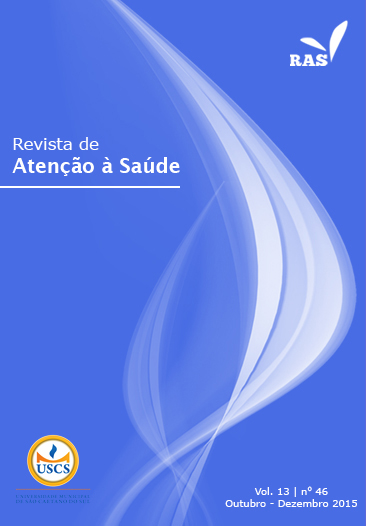EVALUATION OF PORTABLE ULTRASOUND TECHNOLOGY AND THE CORRELATION WITH THE FAT PERCENTAGE THROUGH SKINFOLDS IN YOUNG ADULTS
DOI:
https://doi.org/10.13037/ras.vol13n46.3153Keywords:
Body composition, skinfold thickness, ultrasonography.Abstract
Introduction: The aim of this study was to compare and correlate the results of fat percentage by skinfold thickness using portable ultrasound (US) and scientific adipometer in adults. Methods: During2012 we evaluated 120 military men, divided according to the value of the body mass index (BMI). Wecollected: weight, height, SF and US in nine points (triceps, subscapular, biceps, chest, medium axillary,abdominal, supra iliac, anterior thigh and calf ). Statistical analysis was performed using nonparametrictests as Spearman correlation coefficient and paired with Wilcoxon Signed Ranks Test. Results:For the correlation of the percentage of fat obtained through seven skinfolds and values obtained bymeasuring it with US, the following results were obtained: p=0.421 (BMI<25 kg/m², N= 94); p=0.419(BMI=25 kg/m², N=26); p=0.514 (general BMI, N=120), where all correlations were statistically significant(p<0.05). Points with the highest correlations were the thigh (p=0.65) and triceps (p=0.63). Conclusion: Comparing the percentage of fat estimated between portable ultrasound and adipometer,there were significant correlations between all points assessed, but with lower US values than skin foldthickness at every point analyzed (except for the biceps brachialis). We recommend that future studiesshould be carried out comparing portable US with Dual-energy X-ray absorptiometry, so we could effectively verify if there is a correlation between the diagnoses obtained from this new technology witha gold standard technique.Downloads
References
Whittingham G. Measurement of tissue thickness by ultrasound. Aerospace medicine 1962; 33: 1121.
Booth R, Goddard B, Paton A. Measurement of fat thickness in man: a comparison of ultrasound, Harpenden calipers and electrical conductivity. Br J Nutr 1966; 20: 719-25.
Sloan AW. Estimation of body fat in young men. Journal of Applied Physiology 1967; 23(3): 311-5.
Smith-Ryan AE, Fultz SN, Melvin MN, Wingfield HL, Woessner MN. Reproducibility and Validity of A-Mode Ultrasound for Body Composition Measurement and Classification in Overweight and Obese Men and Women. PLoS ONE 2014; 9(3): e91750.
Fanelli MT, Kuczmarski RJ. Ultrasound as an approach to assessing body composition. The American journal of clinical nutrition 1984; 39(5): 703-9.
Jackson AS, Pollock ML. Generalized equations for predicting body density of men. British Journal of Nutrition 1978; 40(03): 497-504.
Siri WE. Body composition from fluid spaces and density: analysis of methods. Techniques for measuring body composition 1961: 223-44.
Loenneke JP, Barnes JT, Wagganer JD, Pujol TJ. Validity of a portable computer‐based ultrasound system for estimating adipose tissue in female gymnasts. Clinical Physiology and Functional Imaging 2014.
Black D, Vora J, Hayward M, Marks R. Measurement of subcutaneous fat thickness with high frequency pulsed ultrasound: comparisons with a caliper and a radiographic technique. Clinical Physics and Physiological Measurement 1988; 9(1): 57-64.
Pineau JC, Filliard JR, Bocquet M. Ultrasound techniques applied to body fat measurement in male and female athletes. Journal of athletic training 2009; 44(2): 142.
Kitchen S. Eletroterapia: prática baseada em evidências. São Paulo: Manole, 2003.
Neves EB, Ulbricht L, Stadinik AMW, Matos O, Ripka W. Avaliação das medidas de composição corporal obtidas por ultra-som. In: Biomédica SBdE, ed. XXII Congresso Brasileiro de Engenharia Biomédica. Tiradentes-MG 2010:493-6.
Hager M, Utler A. Bodymetrix System vs. Skinfold Caliper vs. Underwater Weighing IntelaMetrix. 2010 [cited 2010 19 ago 2010]; Available from: ttp://yardstickfitness.com/PDF/BodyMetrix%20Validation%20Studies.pdf
Ulbricht L, Neves E, Ripka W, Romaneli E. Comparison between body fat measurements obtained by portable ultrasound and caliper in young adults. Engineering in Medicine and Biology Society (EMBC), 2012 Annual International Conference of the IEEE; 2012: IEEE; 2012. p. 1952-5.
Downloads
Published
Issue
Section
License
Policy Proposal for Journals offering Free Delayed Access
Authors who publish in this magazine agree to the following terms:
- Authors maintain the copyright and grant the journal the right to the first publication, with the work simultaneously licensed under a Creative Commons Attribution License after publication, allowing the sharing of the work with recognition of the authorship of the work and initial publication in this journal.
- Authors are authorized to assume additional contracts separately, for non-exclusive distribution of the version of the work published in this magazine (eg, publishing in institutional repository or as a book chapter), with the acknowledgment of the authorship and initial publication in this journal.
- Authors are allowed and encouraged to publish and distribute their work online (eg in institutional repositories or on their personal page) at any point before or during the editorial process, as this can generate productive changes, as well as increase impact and citation of the published work (See The Effect of Open Access).









